Research on the Fracture Propagation Law of Separate Layered Fracturing in Unconventional Sandstone Reservoirs
Abstract
:1. Introduction
2. Experimental Procedure
2.1. Experiment Preparation
2.2. Experiment Results
3. Constitutive Equations
3.1. Basic Theory of the Cam Model
- (1)
- In the (e, p′) plane, a curve exists in that all stresses in the normally consolidated clay follow this path, which is called the normal consolidation line (NCL). This line provides volume hardening rules that can be generalized to general stress conditions;
- (2)
- There also exists a line in the (e, p′, q) space, and all residual states follow this path, regardless of the experiment class and the initial conditions. This line is parallel to the normal consolidation line in the (e, p′) plane, where shear deformation occurs without volume deformation;
- (3)
- The stress path obtained from the consolidated drainage and undrained experiments is located in a unique state surface, generally known as the Roscoe surface. In fact, in the undrained path, the soil hardens with the development of the plastic volume strain where the sum of the elastic and plastic strain increments of the volume strain remains constant. The value of the Roscoe surface lies in the fact that it provides a basis for selecting the type of the yield surface.
3.2. Constitutive Equation of the Cam Model
- (1)
- Energy equation
- (2)
- Yield surface equation
- (3)
- Stress-strain relationship
3.3. The Modified Cam-Clay Model
4. Numerical Simulation
4.1. Model Building
4.2. The Influence of the Different Displacements
4.3. The Influence of the Different Viscosities
4.4. The Influence of the Different Filtration Coefficients
5. Discussion
- (1)
- The extension of cracks and the settlement law of proppant during the filling and sand removal stages.
- (2)
- The extension direction of cracks under conditions such as different perforation orientations and in situ stresses.
6. Conclusions
- (1)
- Under different permeability conditions, the compressive strength of the unconsolidated sandstone decreases with the increase in the permeability. Under the same stress conditions, unconsolidated sandstone with a high permeability has a greater strain before fracture pressure;
- (2)
- This Cambridge model is edited and correcting the error of the non-zero increase in the shear strain. The hardening parameters were used to represent the plastic volumetric strain when the shear stress was zero;
- (3)
- A three-dimensional numerical model for the separate layer fracturing of the unconsolidated sandstone was established through software. The impact of different construction conditions on hydraulic crack propagation was investigated. Maintaining a fixed fracturing fluid displacement and increasing the viscosity and filtration coefficient of the fracturing fluid, unconsolidated sandstone was found to be more likely to form short and wide cracks. Keeping the viscosity and filtration coefficient of the fracturing fluid unchanged and increasing the displacement resulted in unconsolidated sandstone to be more likely to form long and wide fractures.
Author Contributions
Funding
Data Availability Statement
Conflicts of Interest
References
- Qu, G.Z.; Qu, Z.Q.; Zhu, X.H. Optimal Design of Tip Screenout Fracturing Treatment. Sci. Technol. Eng. 2013, 13, 1602–1605. [Google Scholar]
- Zhang, Q.H.; Zhang, S.C.; Huang, X.D. Systemic design for tip screen out frac-pack sand control and its application in Sebei Gasfield. J. China Univ. Pet. (Ed. Nat. Sci.) 2007, 31, 55–59. [Google Scholar]
- Suo, Y.; Zhao, Y.J.; Fu, X.F.; He, W.-Y.; Pan, Z.-J. Mixed-mode fracture behavior in deep shale reservoirs under different loading rates and temperatures. Pet. Sci. 2023, in press. [CrossRef]
- Suo, Y.; Dong, M.Y.; Wang, Z.J.; Gao, J.H.; Fu, X.F.; Pan, Z.J.; Xie, K.; Qi, T.T.; Wang, G.Z. Characteristics of mixed-mode Ⅰ-Ⅱ fracture of bedding mud shale based on discrete element method. J. Pet. Sci. Eng. 2022, 219, 111135. [Google Scholar] [CrossRef]
- Suo, Y.; Su, X.H.; Wang, Z.J.; He, W.; Fu, X.F.; Feng, F.; Pan, Z.J.; Xie, K.; Wang, G.Z. A study of inter-stratum propagation of hydraulic fracture of sandstone-shale interbedded shale oil. Eng. Fract. Mech. 2022, 275, 108858. [Google Scholar] [CrossRef]
- Suo, Y.; Su, X.H.; Ye, Q.Y.; Chen, Z.; Feng, F.; Wang, X.; Xie, K. The investigation of impact of temperature on mixed-mode fracture toughness of shale by semi-circular bend test. J. Pet. Sci. Eng. 2022, 217, 110905. [Google Scholar] [CrossRef]
- Murdoch, L.C. Hydraulic fracturing of soil during laboratory experiments Part 2. Propagation. Geotechnique 1993, 43, 267–276. [Google Scholar] [CrossRef]
- Murdoch, L.C. Hydraulic fracturing of soil during laboratory experiments. Part 1. Methods and observations. Geotechnique 1993, 43, 255–265. [Google Scholar] [CrossRef]
- Khodaverdian, M.; Mcelfresh, P. Hydraulic fracturing stimulation in poorly consolidated sand: Mechanisms and consequence. In Proceedings of the SPE Annual Technical Conference, Dallas, TX, USA, 1–4 October 2000. [Google Scholar]
- Gil, I.R.; Hart, R.; Roegiers, J.C.; Shimizu, Y. Considerations On Hydraulic Fracturing of Unconsolidated Formations. In Proceedings of the ISRM International Symposium-EUROCK 2005, Brno, Czech Republic, 18–20 May 2005. [Google Scholar]
- Gil, I.R. Hydraulic Fracturing of Poorly Consolidated Formations: Considerations on Rock Properties and Failure Mechanisms; The University of Oklahoma: Norman, OK, USA, 2005. [Google Scholar]
- Zhang, F.; Damjanac, B.; Huang, H. Coupled discrete element modeling of fluid injection into dense granular media. J. Geophys. Res. Solid Earth 2013, 118, 2703–2722. [Google Scholar] [CrossRef]
- Li, W.; Soliman, M.; Han, Y. Microscopic numerical modeling of Thermo-Hydro-Mechanical mechanisms in fluid injection process in unconsolidated formation. J. Pet. Sci. Eng. 2016, 146, 959–970. [Google Scholar] [CrossRef]
- Feng, K. Experimental Study on Physical Properties of Unconsolidated Sandstone Reservoir under Different Compaction; Southwest Petroleum University: Chengdu, China, 2014. [Google Scholar]
- Khodaverdian, M.F.; Sorop, T.; Postif, J.; Van den Hoek, P. Polymer flooding in unconsolidated-sand formations: Fracturing and geomechanical considerations. SPE Prod. Oper. 2010, 25, 211–222. [Google Scholar] [CrossRef]
- Chang, H. Hydraulic Fracturing in Particulate Materials; Georgia Institute of Technology: Atlanta, GA, USA, 2004. [Google Scholar]
- Hurt, R.S.; Germanovich, L.N. Parameters Controlling Hydraulic Fracturing and Fracture Tip-Dominated-Leakoff in Unconsolidate Sands. In Proceedings of the SPE Annual Technical Conference and Exhibition, San Antonio, TX, USA, 8–10 October 2012. [Google Scholar]
- Germanovich, L.N.; Hurt, R.S.; Ayoub, J.A.; Siebrits, E.; Norman, W.D.; Ispas, I.; Montgomery, C. Experimental Study of Hydraulic Fracturing in Unconsolidated Materials. In Proceedings of the SPE International Symposium and Exhibition on Formation Damage Control, Lafayette, LA, USA, 15–17 February 2012. [Google Scholar]
- Golovin, E.; Jasarevic, H.; Chudnovsky, A.; Dudley, J.W.; Wong, G.K. Observation and characterization of hydraulic fracture in cohesionless sand. In Proceedings of the 44th US Rock Mechanics Symposium and 5th US-Canada Rock Mechanics Symposium, Salt Lake City, UT, USA, 27–30 June 2010. [Google Scholar]
- Jasarevic, H.; Golovin, E.; Chudnovsky, A.; Dudley, J.W.; Wong, G.K. Observation and modeling of hydraulic fracture initiation in cohesionless sand. In Proceedings of the 44th US Rock Mechanics Symposium and 5th US-Canada Rock Mechanics Symposium, Salt Lake City, UT, USA, 27–30 June 2010. [Google Scholar]
- Golovin, E.; Chudnovsky, A.; Dudley, J.W.; Wong, G.K. Injection rate effects on waterflooding mechanisms and injectivity in cohesionless sand. In Proceedings of the 45th US Rock Mechanics/Geomechanics Symposium, San Francisco, CA, USA, 26–29 June 2011. [Google Scholar]
- Olson, J.E.; Holder, J.; Hosseini, M. Soft rock fracturing geometry and failure mode in lab experiments. In Proceedings of the SPE Hydraulic Fracturing Technology Conference, The Woodlands, TX, USA, 24–26 January 2011. [Google Scholar]
- Hosseini, S.M. Hydraulic Fracture Mechanism in Unconsolidated Formations. Ph.D. Thesis, University of Texas, Austin, TX, USA, 2012. [Google Scholar]
- Wong, R.; Barr Kry, P. Stress-strain response of Cold Lake oil sands. Can. Geotech. J. 1993, 30, 220–235. [Google Scholar] [CrossRef]
- Wong, T.F.; Szeto, H.; Zhang, J. Effect of loading path and porosity on the failure mode of porous rocks. Appl. Mech. Rev. 1992, 45, 281–293. [Google Scholar] [CrossRef]
- Wong, T.F.; David, C.; Zhu, W. The transition from brittle faulting to cataclastic flow in porous sandstones: Mechanical deformation. J. Geophys. Res. Solid Earth 1997, 102, 3009–3025. [Google Scholar] [CrossRef]
- Fjar, E.; Holt, R.M.; Horsrud, P.; Raaen, A.M. Petroleum Related Rock Mechanics; Elsevier: Amsterdam, The Netherlands, 2008. [Google Scholar]
- Blyton, C.A.; Gala, D.P.; Sharma, M.M. A Comprehensive Study of Proppant Transport in a Hydraulic Fracture. In Proceedings of the SPE Annual Technical Conference and Exhibition, Houston, TX, USA, 28–30 September 2015. [Google Scholar]
- Holcomb, D.J.; Olsson, W.A. Compaction localization and fluid flow. J. Geophys. Res. Solid Earth 2003, 108. [Google Scholar] [CrossRef]
- Zoback, M.D. Reservoir Geomechanics; Cambridge University Press: Cambridge, UK, 2010. [Google Scholar]
- Charlez, P.A. Rock Mechanics, Volume 1: Theoretical Fundamentals; Editions Technip: Paris, France, 1991. [Google Scholar]
- Abou-Sayed, A.; Zaki, K.; Wang, G.; Fanhong, M.; Manoj, S. Fracture propagation and formation disturbance during injection and Frac-Pack operations in soft compacting rocks. In Proceedings of the SPE Annual Technical Conference and Exhibition, Houston, TX, USA, 26–29 September 2004. [Google Scholar]
- Cuss, R.J.; Rutter, E.H.; Holloway, R.F. The application of critical state soil mechanics to the mechanical behaviour of porous sandstones. Int. J. Rock Mech. Min. Sci. 2003, 40, 847–862. [Google Scholar] [CrossRef]
- Morris, J.P.; Lomov, I.N.; Glenn, L.A. Constitutive model for stress-induced permeability and porosity evolution of Berea sandstone. J. Geophys. Res. Solid Earth 2003, 108. [Google Scholar] [CrossRef]
- Crawford, B.R.; Yale, D.P. Constitutive modeling of deformation and permeability: Relationships between critical state and micromechanics. In Proceedings of the SPE/ISRM Rock Mechanics Conference, Irving, TX, USA, 20–23 October 2002. [Google Scholar]
- Crawford, B.R.; Gooch, M.J.; Webb, D.W. Textural Controls On Constitutive Behavior In Unconsolidated Sands: Micromechani And Cap Plasticity. In Proceedings of the Gulf Rocks 2004, the 6th North America Rock Mechanics Symposium (NARMS), Houston, TX, USA, 5–9 June 2004. [Google Scholar]
- Crawford, B.R.; Webb, D.W.; Searles, K.H. Plastic compaction and anisotropic permeability development in unconsolidated sands with implications for horizontal well performance. In Proceedings of the 42nd US Rock Mechanics Symposium (USRMS), San Francisco, CA, USA, 29 June–2 July 2008. [Google Scholar]
- Grueschow, E.R. Yield Cap Constitutive Models for Predicting Compaction Localization in High Porosity Sandstone. Ph.D. Thesis, Northwestern University, Evanston, IL, USA, 2005. [Google Scholar]
- Baud, P.; Vajdova, V.; Wong, T.F. Shear-enhanc compaction and strain localization: Inelastic deformation and constitutive modeling of four porous sandstones. J. Geophys. Res. Solid Earth 2006, 111. [Google Scholar] [CrossRef] [Green Version]
- Baud, P.; Reuschlé, T.; Ji, Y.; Cheung, C.S.; Wong, T.F. Mechanical compaction and strain localization in Bleurswiller sandstone. J. Geophys. Res. Solid Earth 2015, 120, 6501–6522. [Google Scholar] [CrossRef]
- Schofield, A.N.; Wroth, P. Critical State Soil Mechanics; McGraw-Hill: London, UK, 1968; Volume 310. [Google Scholar]
- Terzaghi, K. Theory of Consolidation; Wiley Online Library: New York, NY, USA, 1943. [Google Scholar]
- Das, M. Advanced Soil Mechanics; CRC Press: Boca Raton, FL, USA, 2013. [Google Scholar]
- Verruijt, A. Soil Mechanics; VSSD: Delft, The Netherlands, 2001. [Google Scholar]
- Kavvadas, M.; Amorosi, A. A constitutive model for structured soils. Géotechnique 2000, 50, 263–273. [Google Scholar] [CrossRef]
- Savvides, A.A.; Papadrakakis, M. A computational study on the uncertainty quantification of failure of clays with a Modified Cam Clay Yield Criterion. SN Appl. Sci. 2021, 3, 659. [Google Scholar] [CrossRef]
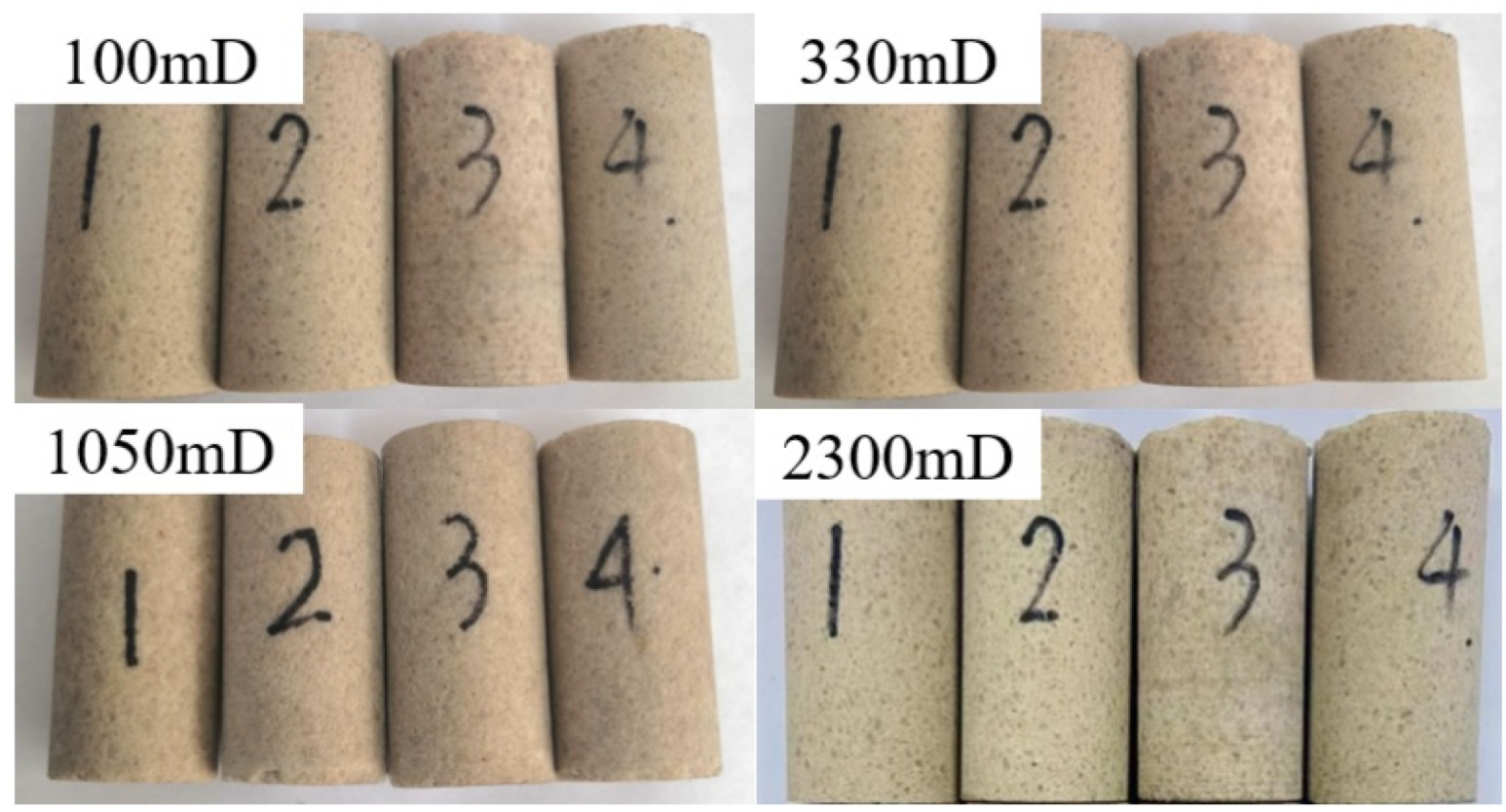
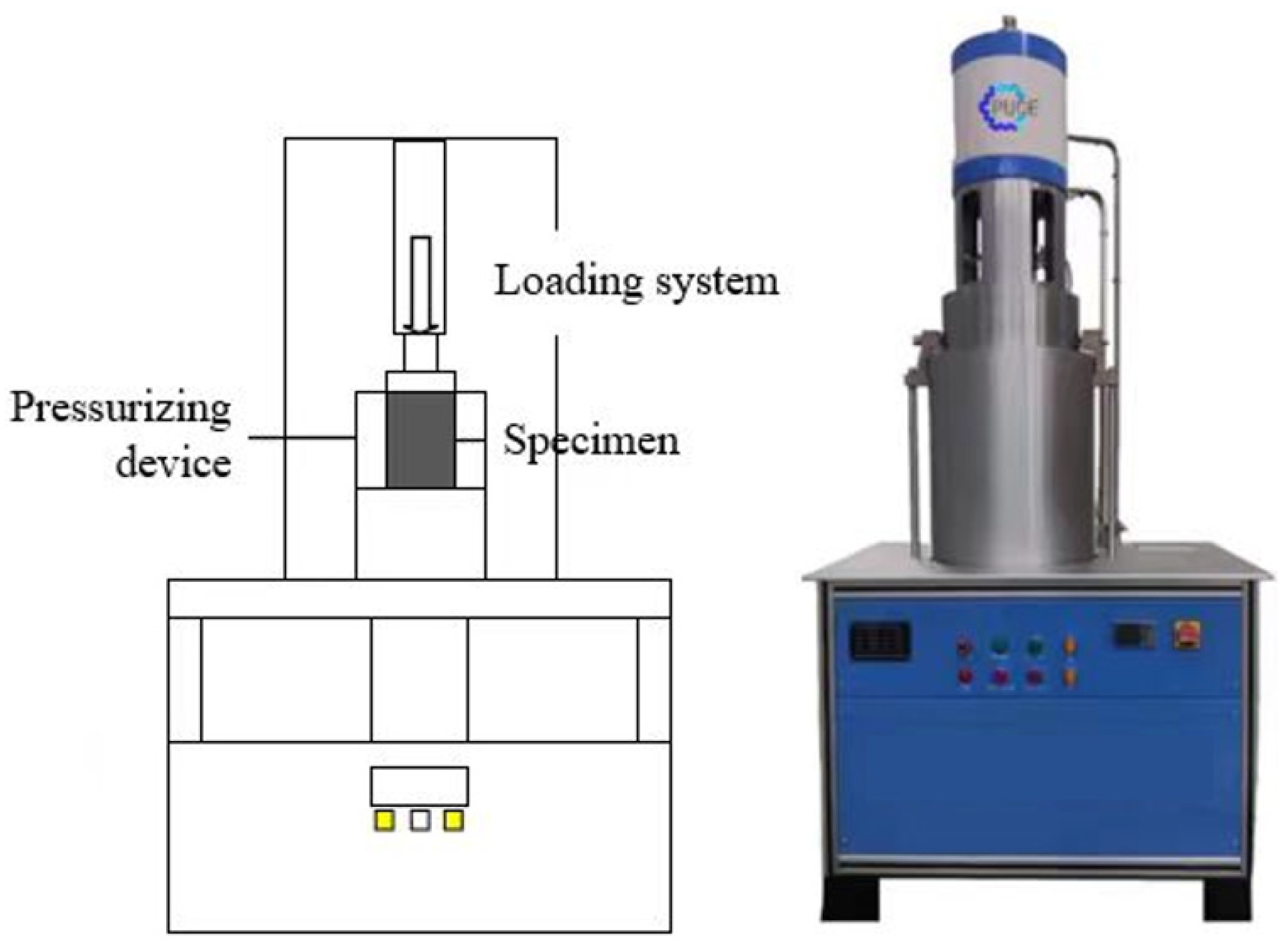

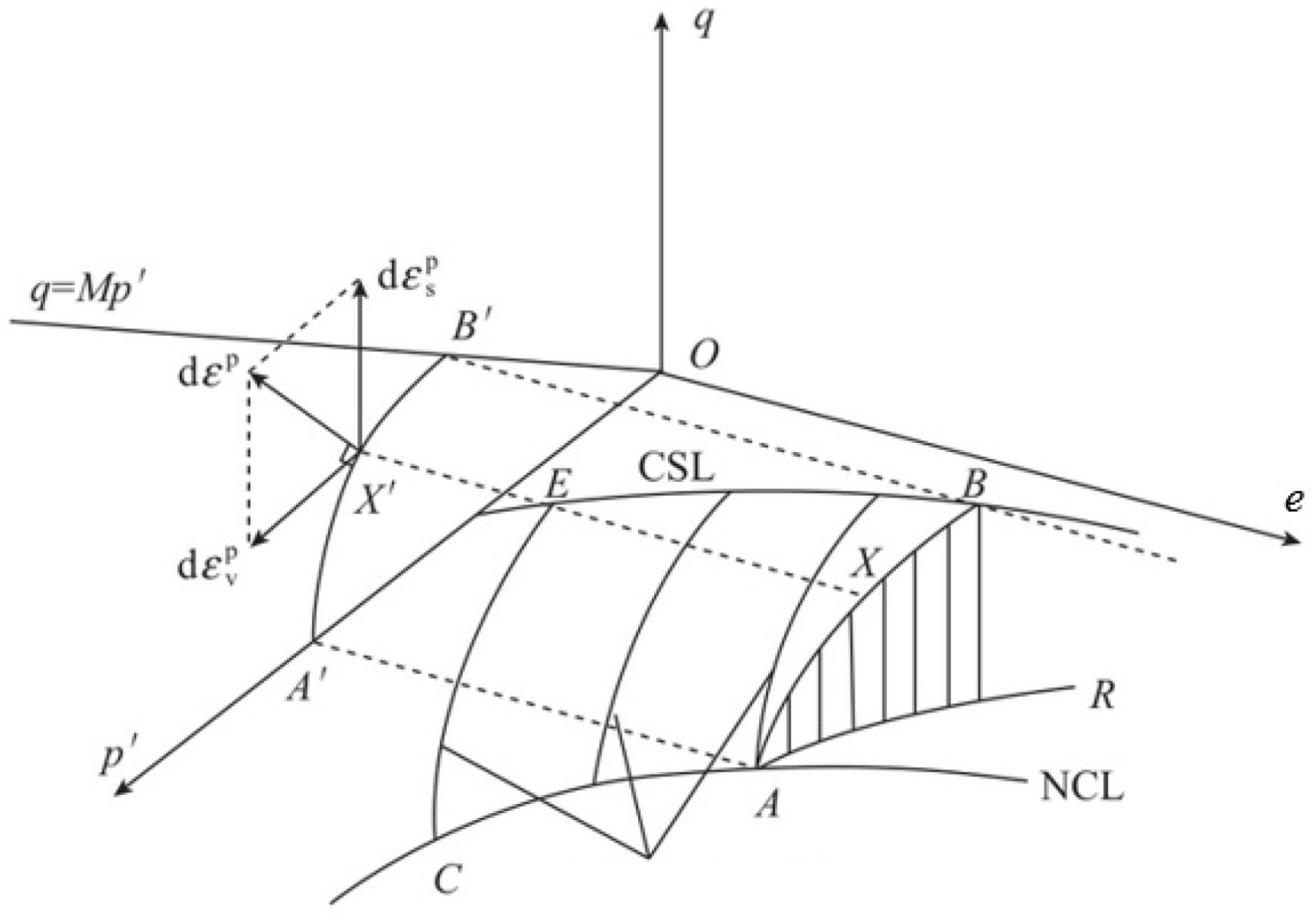
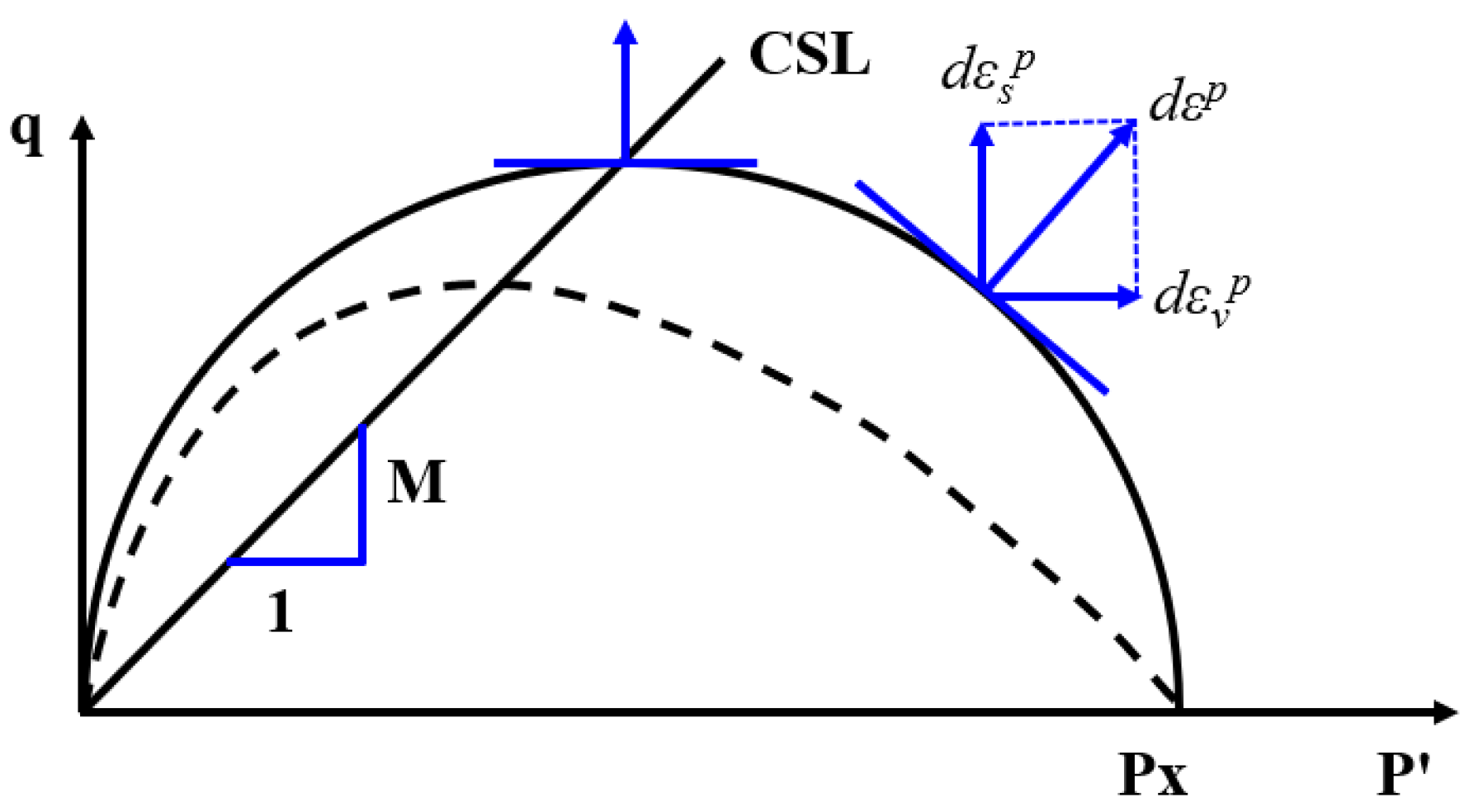
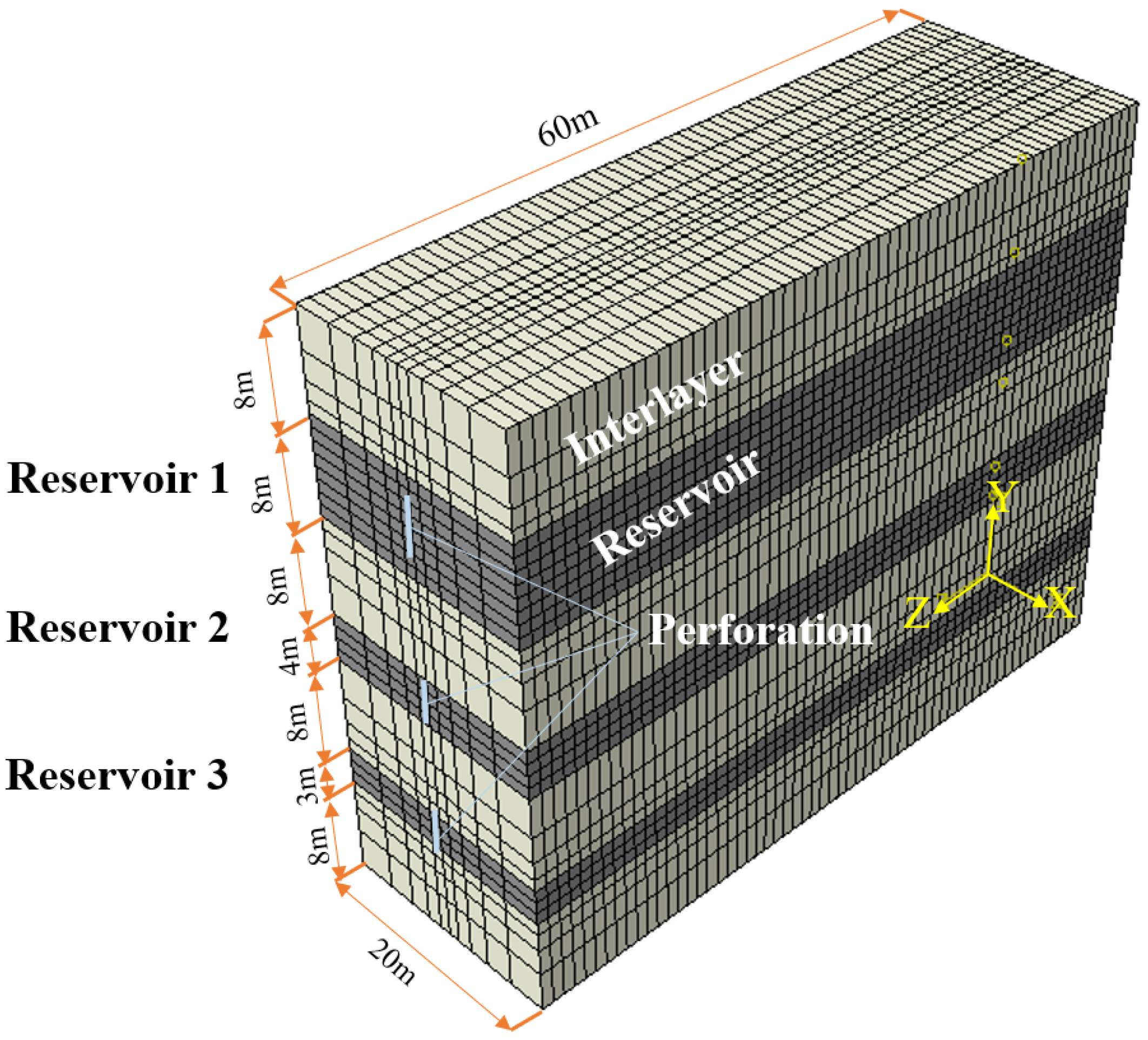









| Physical and Mechanical Properties of Rock | |||
|---|---|---|---|
| Rebound curve slope, | 0.025 | Slope of isobaric consolidation curve, λ | 0.1 |
| Slope of critical state line, | 1.2 | Poisson’s ratio | 0.25 |
| Over consolidation ratio, OCR | 1.203 | Slope of recompression curve, λs | 0.03 |
| Biot | 1 | Upper permeability limit, mD | 15,000 |
| Layer Position | Layer Number | Interval Interpretation of Reservoir Location | Thickness (m) | Porosity (%) | Permeability (10−3 μm2) | Water Saturation (%) | Argillaceous Content (%) | Lithology | Result of Interpretation | |
|---|---|---|---|---|---|---|---|---|---|---|
| Top Boundary | Bottom Boundary | |||||||||
| S2 | 25 | 816 | 824 | 8.0 | 35.5 | 4235.2 | 26.8 | 1.1 | \ | Heavy oil reservoir |
| S2 | 28 | 831 | 834.9 | 3.9 | 33.2 | 3659.3 | 44.5 | 1.4 | \ | Heavy oil reservoir |
| S2 | 30 | 842 | 844.8 | 2.8 | 33.9 | 3577.3 | 36 | 1.3 | \ | Heavy oil reservoir |
| Parameter | Reservoir | Interlayer |
|---|---|---|
| Elasticity modulus (Gpa) | 5 | 8 |
| Poisson’s ratio | 0.25 | 0.3 |
| Permeability (mD) | 1500 | 1000 |
| Horizontal minimum principal stress (Mpa) | 12 | 14 |
| Horizontal maximum principal stress (Mpa) | 17 | 17 |
| Vertical stress (Mpa) | 22 | 22 |
| Pore ratio | 0.35 | 0.35 |
| Tensile strength (Mpa) | 0.2 | 0.2 |
| Fracture energy (J/m2) | 100 | 300 |
| ) | 0.8 | 0.8 |
| Fracturing fluid viscosity (mPa·s) | 20–200 | - |
| Displacement (m3/min) | 1–3 | - |
Disclaimer/Publisher’s Note: The statements, opinions and data contained in all publications are solely those of the individual author(s) and contributor(s) and not of MDPI and/or the editor(s). MDPI and/or the editor(s) disclaim responsibility for any injury to people or property resulting from any ideas, methods, instructions or products referred to in the content. |
© 2023 by the authors. Licensee MDPI, Basel, Switzerland. This article is an open access article distributed under the terms and conditions of the Creative Commons Attribution (CC BY) license (https://creativecommons.org/licenses/by/4.0/).
Share and Cite
Ran, Q.; Zhou, X.; Xu, M.; Dong, J.; Ren, D.; Li, R. Research on the Fracture Propagation Law of Separate Layered Fracturing in Unconventional Sandstone Reservoirs. Sustainability 2023, 15, 10444. https://doi.org/10.3390/su151310444
Ran Q, Zhou X, Xu M, Dong J, Ren D, Li R. Research on the Fracture Propagation Law of Separate Layered Fracturing in Unconventional Sandstone Reservoirs. Sustainability. 2023; 15(13):10444. https://doi.org/10.3390/su151310444
Chicago/Turabian StyleRan, Qiquan, Xin Zhou, Mengya Xu, Jiaxin Dong, Dianxing Ren, and Ruibo Li. 2023. "Research on the Fracture Propagation Law of Separate Layered Fracturing in Unconventional Sandstone Reservoirs" Sustainability 15, no. 13: 10444. https://doi.org/10.3390/su151310444




